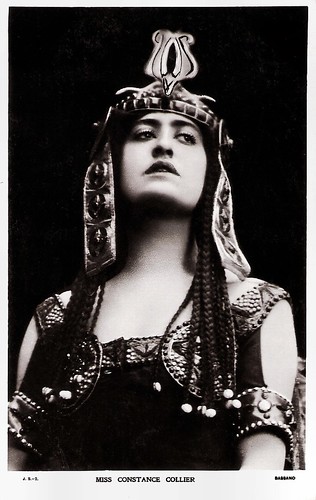
British postcard by J.J. Samuels, London, no. J.S.-2. Photo: Bassano. Publicity still for the stage production 'Antony and Cleopatra' (1906) with Constance Collier as Cleopatra.
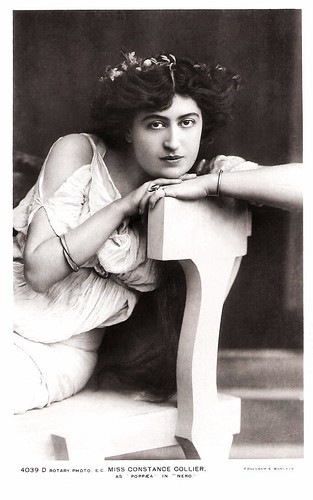
British postcard by Rotary Photo, no. 4039 D. Photo: Foulsham & Banfield. Publicity still for the stage play 'Nero' (1906) with Constance Collier as Poppaea.
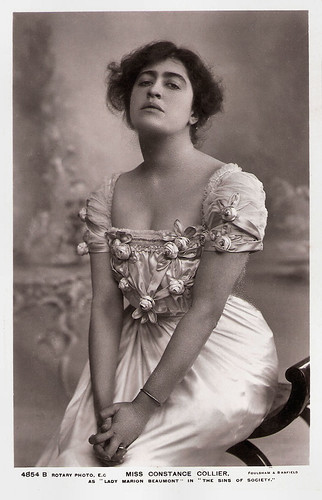
British postcard by Rotary Photo, no. 854B. Photo: Foulsham & Banfield. Publicity still for the stage play 'The Sins of Society' (1907) with Constance Collier as Lady Marion Beaumont.
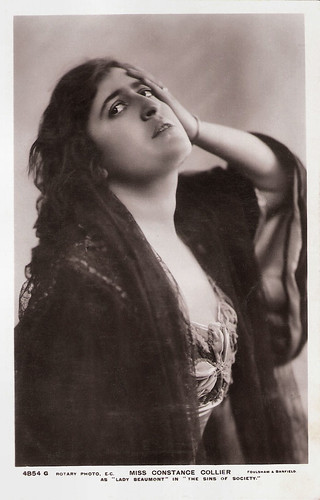
British postcard by Rotary Photo, no. 5854 G. Photo: Foulsham & Banfield. Publicity still for the stage play 'The Sins of Society' (1907) with Constance Collier as Lady Marion Beaumont.
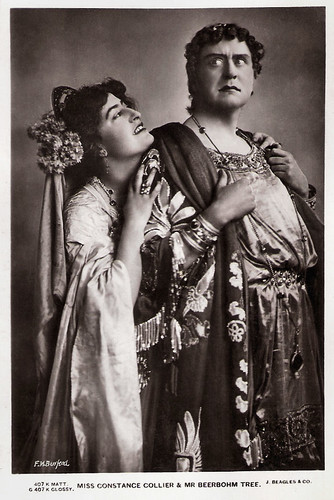
British postcard by Beagles & Co., London no. G 407. Photo: F.W. Burford. Publicity still for the stage production 'Nero' (1906) with Herbert Beerbohm Tree as Nero and Constance Collier as Poppoea, a part she created for the stage. Stephen Phillips’ 'Nero' opened at His Majesty’s Theatre, London, in 1906.
A Gaiety girl
In 1878, Constance Collier was born Laura Constance Hardie, in Windsor, Berkshire. She was the only child of Cheetham Agaste Hardie and Eliza Collier, both minor professional actors. Constance made her stage debut at the age of 3 when she played Fairy Peasblossom in 'A Midsummer's Night Dream'. In 1893, at the age of 15, she joined the famous Gaiety Girls dance troupe of George Edwardes-Hall, based at the Gaiety Theatre in London. Groomed extensively in singing, dancing and elocution, she managed to stand out among those others in the chorus line and went on to featured status in two of Edwardes-Hall's biggest hits, A Gaiety Girl (1894) and The Shop Girl (1894).
In addition, she had an enormous personality and considerable determination. Just after the turn of the century, she was invited to join the theatre company of the esteemed Herbert Beerbohm Tree, who had been searching for a comparably tall leading lady to play opposite him. In 1905, Collier married handsome English actor Julian Boyle (stage name Julian L'Estrange). They performed together for many years until his death in 1918 in New York from the deadly Spanish influenza. No children were born from the marriage.
In 1906, Beerbohm Tree's extravagant revival of Antony and Cleopatra opened at His Majesty's Theatre, with Tree as Mark Antony and Constance Collier as Cleopatra, a performance for which she received much critical praise. Collier was now established as a popular and distinguished actress. In 1908, she starred with Beerbohm Tree at His Majesty's Theatre in J. Comyn's new play The Mystery of Edwin Drood, based on Charles Dickens's unfinished novel. Later that year, she made the first of several tours of the United States. Collier made a successful American stage debut in 1908 with Samson at the Garrick Theatre in New York opposite well-known American actor/playwright William Gillette. During the second tour, made with Beerbohm Tree in 1916, she appeared in four silent films.
Her film debut was The Tongues of Men (Frank Lloyd, 1916), based on a 1913 Broadway play by Edward Childs Carpenter. The other films were the romantic crime drama The Code of Marcia Gray (Frank Lloyd, 1916), Macbeth (John Emerson, assisted by Erich von Stroheim, 1919) as Lady Macbeth opposite Herbert Beerbohm Tree, and an uncredited appearance in Intolerance (D. W. Griffith, 1916). She can be seen being carried through the entrance to the city in the Babylonian part of the film.
She later starred in the British silent films The Impossible Woman (Meyrick Milton, 1919), and Bleak House (Maurice Elvey, 1920) - one of the many silent film versions of Charles Dickens' stories.
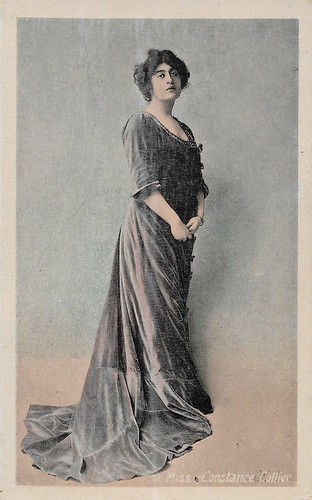
British postcard by unknown editor, printed in Saxony.
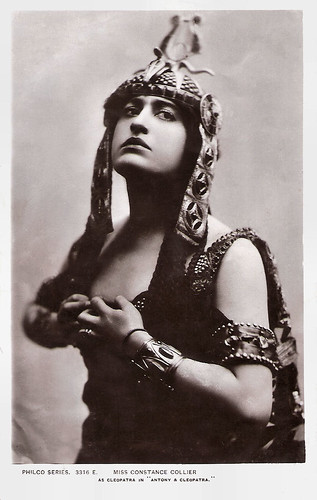
British postcard by The Philco Publishing Co., London, no. 3316 E. Photo: Bassano. Publicity still for the stage production 'Antony and Cleopatra' (1906) with Constance Collier as Cleopatra.
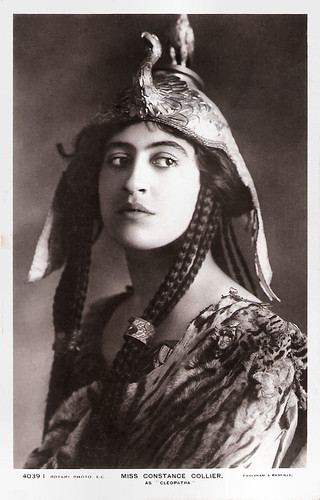
British postcard by Rotary Photo, no. 4039 I. Photo: Foulsham & Banfield. Publicity still for the stage production 'Antony and Cleopatra' (1906) with Constance Collier as Cleopatra.
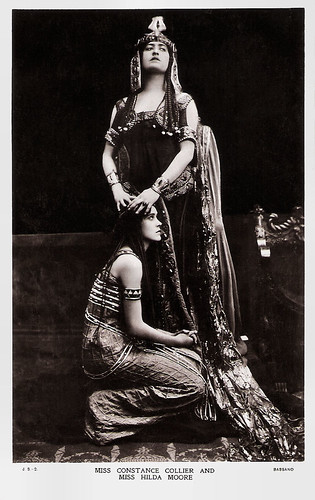
British postcard by J.J. Samuels, London, no. J.S.-2. Photo: Bassano. Publicity still for the stage production 'Antony and Cleopatra' (1906) with Constance Collier and Hilda Moore.
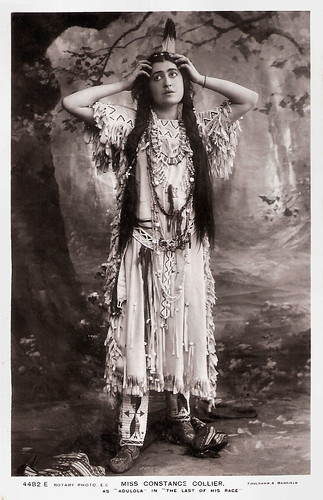
British postcard by Rotary Photo, no. 4482 E. Photo: Foulsham & Banfield. Publicity still for the stage production The Last of His Race (1907) with Constance Collier as Adulola.
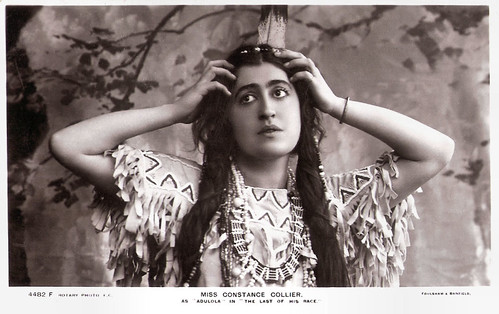
British postcard by Rotary Photo, no. 4482 F. Photo: Foulsham & Banfield. Publicity still for the stage production 'The Last of His Race' (1907) with Constance Collier as Adulola.
Voice coach in Hollywood
In the early 1920s, Constance Collier established a close friendship with Ivor Novello, who was then a young, handsome actor. They appeared together in the film The Bohemian Girl (Harley Knoles, 1922), starring Gladys Cooper. Novello’s first play, 'The Rat', was written in collaboration with her in 1924. She also appeared in several plays with him, including the British version of the American success 'The Firebrand' by Edwin Justus Mayer.
In the late 1920s, Collier relocated to Hollywood where she became a voice coach and teacher in diction. This was during the tumultuous changeover from silent films to sound and many silent actors with no theatre training were scrambling for lessons. Her most famous pupil was arguably Colleen Moore. In 1935, upon her arrival in Hollywood, Luise Rainer hired Collier to improve Rainer's theatre acting and English and to learn the basics of film acting.
Collier nevertheless maintained ties to Broadway and would appear in several plays in the 1930s. Her writing career is notable for her collaboration with Deems Taylor on the libretto of the opera Peter Ibbetson which premiered at the Metropolitan Opera in February 1931 and received mixed reviews. In 1932 Collier starred as Carlotta Vance in the original production of George S. Kaufman and Edna Ferber's comedy 'Dinner at Eight'. The role was played in the 1933 film version by Marie Dressler.
Collier appeared in more than 20 Hollywood films, including Stage Door (Gregory La Cava, 1937) starring Katharine Hepburn, Kitty (Mitchell Leisen, 1945) as the comic Lady Susan, the drunken aunt of Ray Milland, Perils of Pauline (George Marshall, 1947) with Betty Hutton, Rope (Alfred Hitchcock, 1948) and Whirlpool (Otto Preminger, 1949).
Constance Collier was presented with the American Shakespeare Festival Theatre Award for distinguished service in training and guiding actors in Shakespearean roles. Collier was a drama coach for many famous actors, including Audrey Hepburn, Vivien Leigh and Marilyn Monroe. She also coached Katharine Hepburn during Hepburn's world tour performing Shakespeare in the 1950s. Constance Collier died of natural causes in Manhattan in 1955 at the age of 77. The marriage to L'Estrange produced no children and she never remarried. Katharine Hepburn ‘inherited’ Collier's secretary Phyllis Wilbourn, who remained with Hepburn as her secretary for 40 years. Collier has a star on the Hollywood Walk of Fame.

American postcard by Kline Poster Co. Inc., Phila. Illustration: Morosco-Paramount.
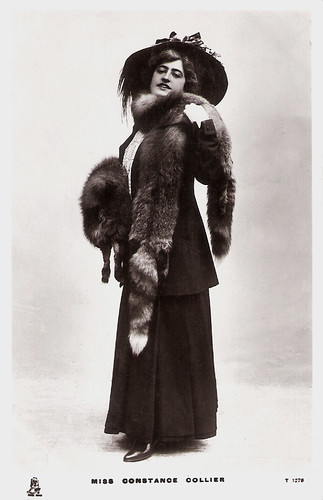
British postcard by Raphael Tuck and Sons, no. T 1278. Photo: Rover Street Studios.
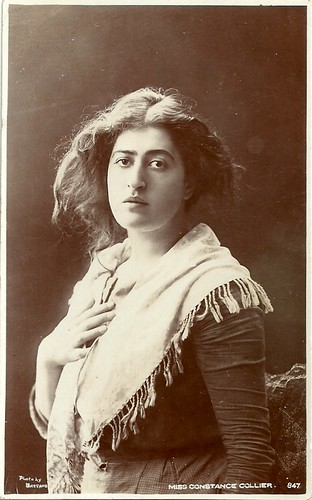
British postcard. A.G. Taylor's Royalty Series, no. 847. Photo Bassano.
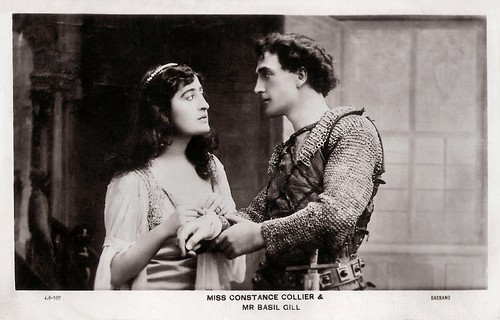
British postcard by J.J. Samuels, London, no. 4-8-102. Photo: Bassano.
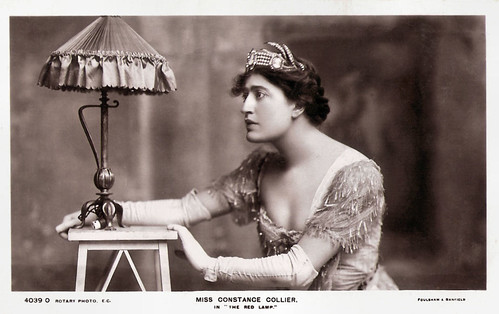
British postcard by Rotary Photo EC, No. 4039 O. Photo: Foulsham & Banfield. Constance Collier in the play 'The Red Lamp' (1907)
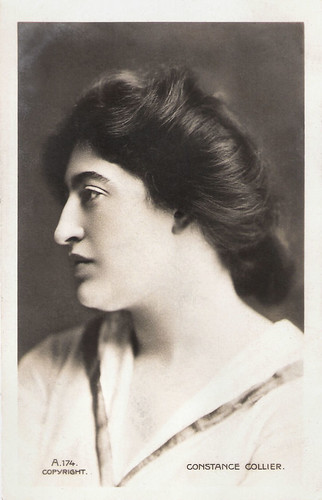
British postcard by Ralph Dunn & Co., London, no. A. 174. Sent by mail in 1905.

British postcard. Ed. D & D, mailed in 1906. Photo: C.W. Faulkner & Co,, c. 1895.
Sources: Gary Brumburgh (IMDb), Wikipedia and IMDb.
This post was last updated on 2 October 2023.
No comments:
Post a Comment